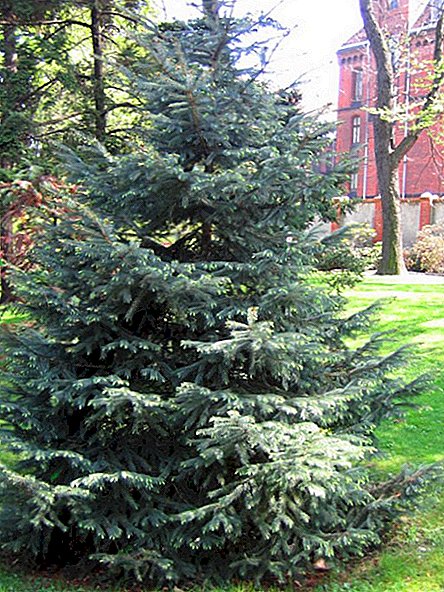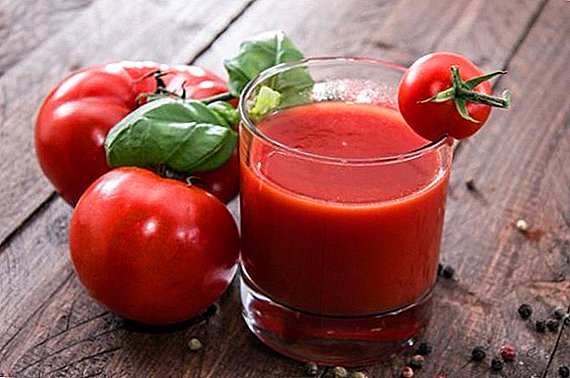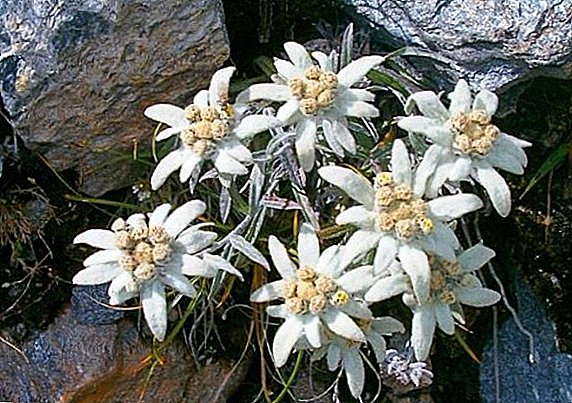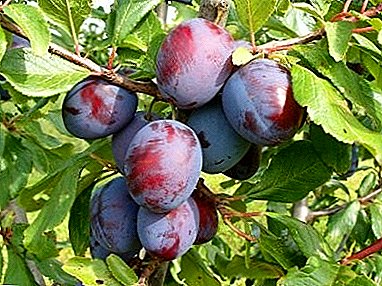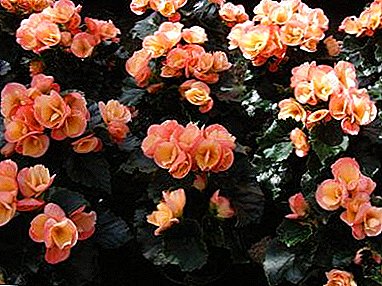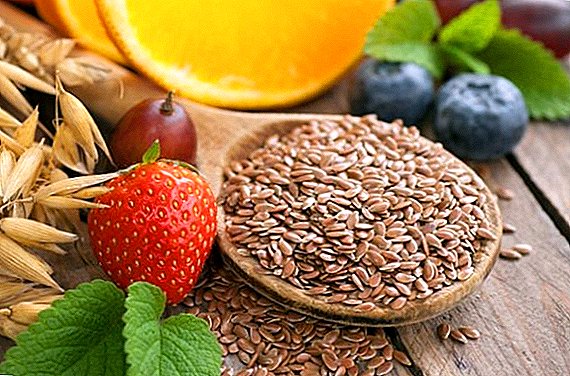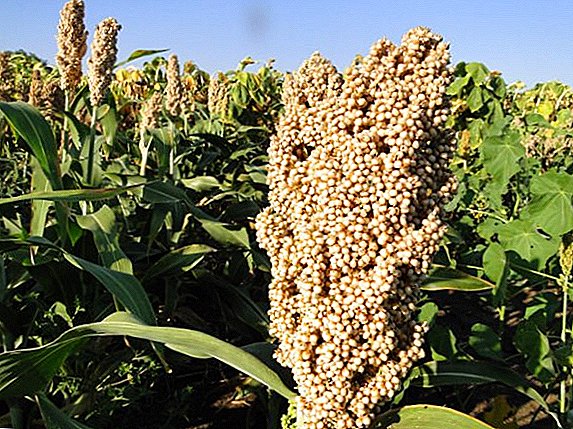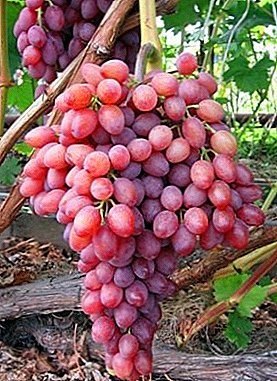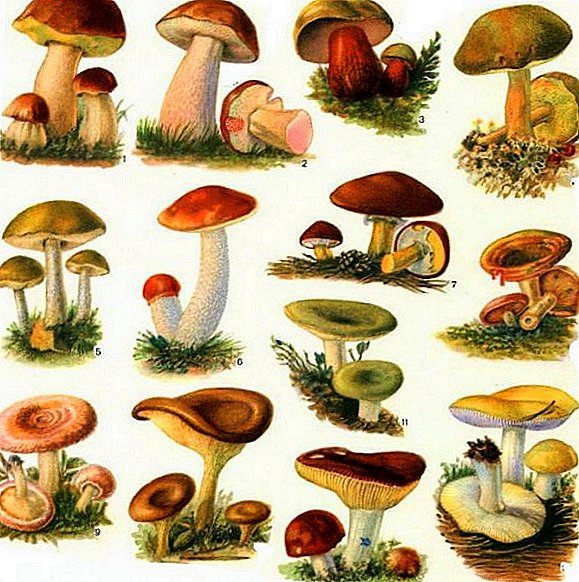 The beginning of autumn - the peak of the harvest of mushrooms. At this time, every lover of this product hurries into the woods in order to collect a full basket of mushrooms and prepare them for the winter. And here begins the first difficulties associated with how to distinguish an edible mushroom from an inedible mushroom — in order not to be mistaken, you need to know what each species looks like and at what period of harvest. To understand this will help our article.
The beginning of autumn - the peak of the harvest of mushrooms. At this time, every lover of this product hurries into the woods in order to collect a full basket of mushrooms and prepare them for the winter. And here begins the first difficulties associated with how to distinguish an edible mushroom from an inedible mushroom — in order not to be mistaken, you need to know what each species looks like and at what period of harvest. To understand this will help our article.
Edible Mushrooms
Edible mushrooms number several thousand species. We will tell only about some - those that grow in our latitudes and are most popular.
White mushroom
Considered mushroom is among the most famous. It is also called boletus or just white. Distributed in forests where there is spruce, pine, oak, birch, and the ground is covered with moss or lichen. A ripe boletus has a cap ranging in size from 7 to 30 cm in diameter.
There are specimens with a cap of about 50 cm. It is convex in shape, and in elderly people it is flat-convex with a smooth or wrinkled surface. If the weather was dry for a long time, the hat may crack. At this time, it becomes matte or shiny. With an excess of moisture slightly covered with mucus.
We recommend to get acquainted with the types and beneficial properties of porcini mushrooms, as well as learn how to prepare porcini mushrooms for the winter.

The color of the fungus, or rather, its cap, depends on what tree it grows under. So, under the oak it is hazelnut or chestnut in color, under the pine tree it is purple-brown (brown), and more often under aspen and birch it is light yellow with a reddish tinge.
The color may not be uniform (the edges are slightly lighter, or a thin rim appears white or with a yellow tinge). The skin is difficult to separate from the juicy, soft pulp (context) white. Over time, the color of the boletus context changes: it acquires a yellowish tint, fibers appear in the structure. Its aroma and taste are pleasant.
The hat keeps on a long leg, 8-25 centimeters (more often no more than 12 cm). The width of the legs about 7 cm. Sometimes they are up to 10 cm wide and more. The shape resembles a barrel or a mace. In adult borovik often takes a cylindrical shape or expands / narrows in the central part.
Video: how and where to pick white mushrooms It may be whitish, brownish, less often reddish or a couple of shades lighter than the cap. The outer part of the leg is covered with white or slightly lighter than the general tone of the leg veins - usually they are visible only in the upper part.
The harvest season of the boletus in the northern regions of the temperate zone falls in mid-June to late September. Harvest peak is the second half of August. In warmer areas you can find fungus in May and October. White mushroom can be fried, boiled, dried, marinated. Powdered dried boletus can be used as a dressing.
Important! Boletus retains color after drying and acquires a unique flavor.
White sub
White or dry load belongs to the genus Syroezhek. Appears on the edges of all major types of forests of the Eurasian continent. Usually grows near birch, oak, beech, spruce, pine, aspen. Adult podgazdki have a cap with a diameter of 5-18 centimeters.  In young animals, it is convex, then becomes concave and funnel-shaped. Its outer layer is white, occasionally covered with dark yellow or red-brown spots. In the absence of moisture, the cap often cracks. The plates are frequent, cream-colored, closer to the base get a light blue tint.
In young animals, it is convex, then becomes concave and funnel-shaped. Its outer layer is white, occasionally covered with dark yellow or red-brown spots. In the absence of moisture, the cap often cracks. The plates are frequent, cream-colored, closer to the base get a light blue tint.
The leg is short, 2-6 centimeters, in width - 1,5-3 centimeters, it is narrowed upwards. It is painted white, sometimes with brown spots, it may have a bluish tint near the cap. The inner layer is dense, white: in young fruits with a fruity aroma, in old ones with a fishy flavor. It tastes bland.
Mushroom is used after 15-20 minutes of cooking. So that the taste of the podruzhdka was better, it should be salted during cooking. Also, the fungus can be pickled, pickled or dried. Harvest time - August - October.
Video: podgruzdok white
Valui
He is also called a bull, a mushroom plakun, a pig-broiler, a small whitefish, a crook, a cubar, a cam, a bogger, a cowshed. It prefers coniferous and deciduous forests of our hemisphere, it also loves birch forests.
It will be useful for you to learn more about such edible mushrooms as boletus, volnushki, raincoats, bovines, goatlings, boletus mushrooms, aspen mushrooms, morels, russules, and mushrooms.
Most often, a hat is 8–12 cm in diameter, sometimes it reaches 15. It is yellow or yellow-brown in color, the surface is shiny and slimy. The spherical shape of the cap of young animals is gradually transformed into a flat one, with a small notch in the center and well-visible hollows on the edge.
The inner layer of the fungus is white, fragile, it begins to darken in the air and becomes brown - it tastes bitter and hot, exudes a fragrance similar to the smell of spoiled oil.  Leg Valuya white, in the form of a cylinder or barrel. Its length is 6-12 centimeters, the thickness is about 3. Often covered with brown spots, most often below, in ripe mushrooms it is hollow and loose.
Leg Valuya white, in the form of a cylinder or barrel. Its length is 6-12 centimeters, the thickness is about 3. Often covered with brown spots, most often below, in ripe mushrooms it is hollow and loose.
In the west, Valui is referred to as inedible mushrooms. In our area, it is considered conditionally edible. It is usually salted, sometimes marinated, can be eaten boiled. Broth with value should be merged.
Important! Before salting the mushroom must be soaked or boiled and peeled. This procedure helps to remove bitterness. It is better to harvest young women with an unopened cap.
Oyster mushroom
Oyster mushroom, oyster, or oyster mushroom is a fairly large mushroom that has a hat with a diameter of 5-15 cm, sometimes up to 30 centimeters. In outline, the cap resembles an auricle with tucked edges. After a while, the edge turns around and becomes wavy. Convex cap of young animals gradually transformed into flat and funnel-shaped. 
We advise you to get acquainted with the methods of growing oyster mushrooms at home in bags, as well as methods of freezing and drying oyster mushrooms.
Its surface is smooth, glossy, can be wavy. The color changes from dark gray or brown to ash gray with a purple hue when the fungus begins to age. The saturation of the color also fades away, and the cap becomes whitish, greyish or yellowish.
Due to the fact that the mushroom grows on trees or stumps, its leg is short, 2-5 centimeters long. At the same time, it is dense, solid, cylindrical. Usually grows on the side of the cap or offset from its center, painted white. From above it is smooth, from the bottom a little felt.
In young, the context is white, elastic and juicy. When the fungus matures, it becomes stiff, fibrous in structure. Its aroma is poorly perceptible, the taste is pleasant, with anise notes.  Oyster mushroom grows on dry woods or weakened deciduous trees (oak, birch, mountain ash, aspen, willow). The harvest season is autumn, in some areas the mushroom does not disappear until December.
Oyster mushroom grows on dry woods or weakened deciduous trees (oak, birch, mountain ash, aspen, willow). The harvest season is autumn, in some areas the mushroom does not disappear until December.
It is considered a dietary product due to the low number of calories and a large number of nutrients. Eat only the caps of young mushrooms, because the legs are harsh. They are boiled, fried and dried.
Wolf
The Wolf Cub is popularly known as volnyanka, Volzhanka, volvenka, volvynitsa, volminka, wave, rubella, dyeing, boil-over. It grows in all forests where there is birch, forming mycorrhiza with the tree.
The cap has a diameter of 4-12 centimeters. At first it is convex, later becomes flat, and a notch appears in the center, its edge is always turned down. The surface of the cap is dotted with hard villi, growing concentric circles, the skin is slightly in mucus.  The color of the cap is greyish-pink, brick-pink, darker in the center than on the edge. In the absence of moisture, the cap becomes pale pink, sometimes almost white.
The color of the cap is greyish-pink, brick-pink, darker in the center than on the edge. In the absence of moisture, the cap becomes pale pink, sometimes almost white.
The inner layer of the fruit body is fleshy, white. Near the skin has a pinkish tinge, and in the leg reddish. The fungus has almost no smell, but the taste is burning-acrid, and it does not turn a different color to the air.
Did you know? For the winds, such a thing as milky juice is characteristic. It is allocated mainly from plates and a cap. It is corrosive and does not change its white color upon contact with air.
Volnyanka's leg is thin and short, but strong. In length, it is 3-6 centimeters with a diameter of 1-2 centimeters, painted in pink. As the fungus grows, a cavity appears inside its leg, the leg itself narrows towards the base, and its color changes to pale pink.
Video: volushka mushrooms Outside, it is dotted with small villi, occasionally may be in the pits, wrinkled. It's time to collect the winds: end of June - October. There are several peaks of harvest: the last days of July, the end of August - the first days of September. Waffle belongs to conditionally edible mushrooms: it can be salted and pickled.
For blanks, small young mushrooms are most suitable, whose cap is no more than 3-4 cm. Before harvesting the wolfberry for the winter, it must be soaked well and blanched. Salted fluffs can be consumed after 45-50 days.
Real bum
This mushroom is referred to as gruzdem - white, raw or wet. It grows in all forests where there are birches: they find it in the northern regions of Russia, Belarus, the Volga region, in the Urals, and Western Siberia. It’s not so easy to find a dummy - it hides well under fallen leaves.  The flat-convex bonnet over time transforms into a funnel-shaped, its edges are lowered and tucked. Its diameter is 5-20 centimeters. The outer shell of the cap is the mucous milky-white or yellowish skin with subtle concentric zones.
The flat-convex bonnet over time transforms into a funnel-shaped, its edges are lowered and tucked. Its diameter is 5-20 centimeters. The outer shell of the cap is the mucous milky-white or yellowish skin with subtle concentric zones.
We recommend to read about what types of mushrooms exist, what are useful mushrooms, as well as how to collect and harvest black, aspen and white loads.
Keeps the cap on a small cylindrical hollow leg of white or yellow color. Leg length 3-7 centimeters, diameter - 2-5. Outside it is smooth, but it can be dotted with yellow spots or pits. The flesh and the milky juice are white, exuding the aroma of fruit. The taste of the pulp is sharp, and the juice - acrid. Contacting with the air, the juice changes color to gray-yellow.
In cold areas they collect milk from the second month of summer to the first month of autumn. In the southern regions - from August to September. The fungus begins to grow massively when the average daily temperature at the surface of the earth reaches + 8-10 ° C - at this time the peak of its harvest.  Milk mushrooms belong to conditionally edible mushrooms, so they should be soaked before consumption, in order for bitterness to disappear, after that it can be salted. Ready to eat after 40-50 days.
Milk mushrooms belong to conditionally edible mushrooms, so they should be soaked before consumption, in order for bitterness to disappear, after that it can be salted. Ready to eat after 40-50 days.
Giant raincoat
The second name of the fungus - giant giant. It looks like a white ball or egg with a diameter of about 50 centimeters. Over time, its color changes to yellow and brown, and it cracks.
Peel disappears, exposing the inside of white color, which gradually turns yellow and green, can take on an olive-brown shade. There is a raincoat in autumn on the edge of deciduous and mixed forests, in fields, meadows, gardens.
Only young golovach is suitable for use, while its flesh has not yet changed color. You can eat fresh, after a short heat treatment, but you can also dry it, cutting it into thin pieces. The workpiece must be kept on the day of collection. 
Did you know? Calvacin, a substance with an oncostatic effect, is obtained from the giant glanadel. Also, the substance is used as a hemostatic.
Goat
Goat or lath is a tubular mushroom that grows in the pine forests of a temperate strip on sour, nutritious and moist soils. It is found along roads and on peat bogs. The convex or flat-convex head of the lattice with a diameter of 3-12 cm with the growth of the fungus is gradually transformed into a flat one.
It feels smooth and sticky to the touch. When moisture is not enough, the peel on the cap glitters, and at high humidity it becomes covered with mucus. Its color is reddish-brown, yellowish-brown, red-brown. It is extremely difficult or even impossible to remove the skin from the cap.
Under the skin lies a dense, elastic pale yellow or light yellow flesh, which gradually becomes rubber. Inside leg red, brown or brown shades. On the air, the flesh reddens or turns pink, its taste is either absent, or slightly sour, the flavor is mild.  Leg height of 4-10 centimeters with a width of 1-2. Solid, cylindrical, sometimes curved or narrowed down, smooth to the touch, matte. The same color as the cap, or a tone lighter, near the base with yellowness.
Leg height of 4-10 centimeters with a width of 1-2. Solid, cylindrical, sometimes curved or narrowed down, smooth to the touch, matte. The same color as the cap, or a tone lighter, near the base with yellowness.
The gathering time of the kid is August-September. It can be eaten fresh (after 15 minutes of boiling), as well as salted and pickled.
Chanterelle
The genus of funnel-shaped fungi, from which it received its Latin name (cantharus). They are symbiotic with coniferous and deciduous forests.
Chanterelle fruit body is fleshy, yellow or red, rarely white or gray. The fleshy cap with a blunt edge smoothly passes into a wide short leg. The white or yellow inner part of the fruit body with a light aroma of dried fruit in the air usually acquires a blue tint.  In some species, it is redder or does not change color at all. In the genus of chanterelles there are no poisonous mushrooms, but they have a lot of dangerous twins for our body. There is also a false chanterelle, which is not eaten. Collect a mushroom in the summer and autumn after the thunderstorm rain. It is fried, boiled, salted, dried and frozen.
In some species, it is redder or does not change color at all. In the genus of chanterelles there are no poisonous mushrooms, but they have a lot of dangerous twins for our body. There is also a false chanterelle, which is not eaten. Collect a mushroom in the summer and autumn after the thunderstorm rain. It is fried, boiled, salted, dried and frozen.
We advise you to read about where chanterelles grow and how not to get false mushrooms, how useful they are, and how to pickle and freeze chanterelles at home.
Maslata
Oiler - a genus of tubular mushrooms, so named because of the slippery and oily cap. The main thing that distinguishes them from similar genera is the skin that is sticky with mucus, which can be easily removed, as well as the ring that remains from the protective shell. They are symbiotic with trees in coniferous forests of the temperate zone of our hemisphere.
The cap of the oiler is flat, flat-convex or convex, smooth, sticky and slimy to the touch. The inner layer is white or yellow. Its color changes to blue or red when interacting with air.  Leg without oil cavity, homogeneous or grainy. From above, under the bonnet, there may be a ring on it, left over from the protective sheath. Harvest time falls in June-November. Butters are eaten in any form, the main thing is to remove the skin from the cap before use.
Leg without oil cavity, homogeneous or grainy. From above, under the bonnet, there may be a ring on it, left over from the protective sheath. Harvest time falls in June-November. Butters are eaten in any form, the main thing is to remove the skin from the cap before use.
Mokhovik
A genus of tubular fungi from the same order as a boletus. They love to grow among moss in coniferous and deciduous forests, which is why they got their name. Distributed in temperate climates of both hemispheres.
Mokhovik is inconspicuous in appearance: its cap is hemispherical, slightly flattened, dry, slightly velvety, and at high humidity it may become sticky. In ripened mushrooms, it cracks - white, yellow or red flesh is seen through the cracks.
In most species, it becomes blue in contact with air. Most species have a long, thin, solid leg. Outside, it can be smooth or shriveled.  Mokhovik is painted in such colors: gray-yellow, yellow-brown, dark brown, red-yellow, yellow-brown, golden brown. Collect a mushroom from summer to autumn. Virtually all types of boletus are boiled, fried, dried, salted and pickled.
Mokhovik is painted in such colors: gray-yellow, yellow-brown, dark brown, red-yellow, yellow-brown, golden brown. Collect a mushroom from summer to autumn. Virtually all types of boletus are boiled, fried, dried, salted and pickled.
Boletus
A group of species of fungi belonging to the genus Lekcinum. They look inconspicuous, in gray-brown tones. From the name it is clear that boletus grows where there is birch.
Their hat looks like a whipped pillow of gray, brown or brown. Its diameter is small - from 4 to 12 centimeters. Keeps on a long (up to 12 centimeters) thin leg of white or gray color. The surface of the stem is densely covered with small dark brown plates.  The inner layer is solid, evenly painted white. Interacting with air, as a rule, does not change color. In some species may turn pink, go green, turn black. The collection time for boletus is summer-autumn. Edible in any form. Rarely wormy.
The inner layer is solid, evenly painted white. Interacting with air, as a rule, does not change color. In some species may turn pink, go green, turn black. The collection time for boletus is summer-autumn. Edible in any form. Rarely wormy.
Boletus
Another group of species of fungi belonging to Lekcinum. Unlike boletus mushrooms, they are clearly visible from afar thanks to the bright red-orange cap, the color of autumn foliage. Perhaps because of the autumn color, and maybe due to the fact that they grow under aspens, the mushrooms got their name.
They are found in the forest zone of the Eurasian continent and in North America. The bright cap of an orange-cap boletus sits tightly on a massive high (up to 22 cm) stem. Over time, the hemisphere from below expands, and from above flattens, and the cap becomes pillow-shaped.  Its skin is dry, less often velvet or felt. Often, the skin is larger than the cap and slightly dangles from it at the edges, it is removed very badly. The color and structure of the leg of an aspen is the same as that of a boletus: it is also covered with small scales, but much more massive, wider and in shape somewhat similar to a mace.
Its skin is dry, less often velvet or felt. Often, the skin is larger than the cap and slightly dangles from it at the edges, it is removed very badly. The color and structure of the leg of an aspen is the same as that of a boletus: it is also covered with small scales, but much more massive, wider and in shape somewhat similar to a mace.
Above, under the cap, there is a porous layer 1-3 centimeters wide: there are practically no scales on it, and it differs in color from the general color of the stem. The inner layer of the fruit body is fleshy, elastic, dense, fibrous in the stem. In the air turns blue, after black.
They are found aspen mushrooms under spruce, oak, birch, beech, aspen, willow, poplar. Harvest season - from summer to autumn. Aspen mushrooms are very useful mushrooms, they are even referred to a number of dietetic due to their low calorie content. Mushrooms can be put out, fried, boiled, marinated, dried or frozen.
Video: mushrooms aspen mushrooms
Important! In order for the aspen birds to lose their color, it is enough to soak them in a half-percent solution of citric acid.
Morel
Съедобный гриб, который можно встретить весной в лесах, парках, садах, особенно если в этом месте года три-четыре назад был пожар. Noticing this mushroom, an inexperienced mushroom picker is unlikely to take it as edible.
And it is not surprising, because the look he is not at all attractive, and in form it differs from other mushrooms. On a small stem sits a cone-shaped or egg-shaped cap, the structure resembling a porous sponge of all shades of brown. A hat can be more than a leg or vice versa.
It is so tightly fastened on the stem that it is very difficult to separate it, so the morels are usually cooked whole or completely crushed into small pieces. They taste watery bitter, pleasant aroma, but not expressive.  In the food they add finely crumbled, raw or dried and ground into powder. Combined with many dishes. Morels are collected in spring in wet weather in coniferous and deciduous forests, in places with lime or clay soil.
In the food they add finely crumbled, raw or dried and ground into powder. Combined with many dishes. Morels are collected in spring in wet weather in coniferous and deciduous forests, in places with lime or clay soil.
Russula
Genus of lamellar fungi growing in mixed forests of the temperate zone. In young animals, the cap is spherical, hemispherical in shape or similar to a bell. Over time, it expands and becomes flat, funnel-shaped, sometimes convex.
Its edge can be wrapped either straight, striped or ribbed. The diameter of the cap is 4-10 centimeters. From above it is covered with skin of different colors: green, brick, pink, pink-red, red-brown, white, yellowish.  The stem is either white or the color of the cap, 3 to 12 centimeters long: in young, it is dense and solid, in adult mushrooms it is hollow. The inner layer is white or with a pink tinge, it can be pungent, bitter, acrid. Its aroma is mild.
The stem is either white or the color of the cap, 3 to 12 centimeters long: in young, it is dense and solid, in adult mushrooms it is hollow. The inner layer is white or with a pink tinge, it can be pungent, bitter, acrid. Its aroma is mild.
Most types of russule are edible, but each has its own cooking characteristics: with one you can do anything, while others are suitable only for pickling or drying. If the flesh of the russula is burning-tart, it is definitely not edible. Gather them in summer and autumn.
You will probably be interested to read about which mushrooms are edible and poisonous, and also to learn how to check the mushrooms for edibility using popular methods.
Redhead
A group of species of fungi belonging to the genus Mlechnik. Their main difference from other edible mushrooms is the bright color (yellow-pink, orange-red) of the whole fruit body, the same bright colors and the milky juice. Ryzhik owes its expressive color to the beta carotene contained in it.  Getting into the human body, this chemical compound is transformed into vitamin A. There are also a lot of ascorbic acid, vitamins of group B, and mineral salts in mushrooms, therefore it is very useful.
Getting into the human body, this chemical compound is transformed into vitamin A. There are also a lot of ascorbic acid, vitamins of group B, and mineral salts in mushrooms, therefore it is very useful.
In an adult mushroom cap can reach a diameter of 15 centimeters. In the center there is a hollow, and the edges are slightly wrapped down. To the touch it is smooth, sometimes sticky.
Orange shades pulp with prolonged contact with air becomes green. It has a bitter and slightly tart taste, the aroma is weak, barely perceptible. Leg length 7-9 centimeters, hollow, cylindrical. If you press on it, it will immediately crumble.
Ryzhiki begin to ripen in mid-July and do not disappear until frost. You can find them on the north side of the trees in the coniferous forests of the temperate zone of our hemisphere. Eat them fried and salted.
Video: how and where to collect mushrooms
Did you know? Ryzhiki do not grow and ripen alone - if one or two mushrooms are found, it means that there are still quite small ones nearby.
Champignon ordinary
Common champignon, real champignon or caverica is a popular edible mushroom that grows among grass in gardens, parks, cemeteries: wherever there is a rich soil humus.
It will be useful for you to learn more about the technology of growing champignons at home, about how to properly clean these mushrooms, what is their benefit and harm.
A cap of a pecheritsy in the diameter of 8-15 centimeters. Its hemispherical shape gradually turns into a flat-rounded, and then into a flat. In young champignons, the edge of the cap is strongly bent inward. Usually it is white, sometimes with a brownish tinge, dry, slightly silky or in small scales.  The flesh is elastic, white, does not change color when in contact with air, it tastes pleasant, with a faint mushroom flavor. Leg medium length (5-9 cm) with a thickness of 1-2 centimeters, smooth, can be extended at the base, white. Around the middle of the leg is a wide ring. Mushroom picking season - May-October. In food suitable in any form.
The flesh is elastic, white, does not change color when in contact with air, it tastes pleasant, with a faint mushroom flavor. Leg medium length (5-9 cm) with a thickness of 1-2 centimeters, smooth, can be extended at the base, white. Around the middle of the leg is a wide ring. Mushroom picking season - May-October. In food suitable in any form.
Inedible, poisonous mushrooms
The mushroom can be non-toxic and cause only mild ailment. But it is better to be careful when eating an unfamiliar mushroom. And in order to know for sure what kind of mushroom is in front of you, well study the following description of some poisonous specimens.
Death cap
Pale grebe, or green mushroom, is the most poisonous mushroom in the world. It is easy to confuse with champignon, russula, greenfinch. Even the fourth part of the fungus causes severe poisoning: vomiting, muscle pain, colic, constant thirst, and diarrhea occur within two days.
Pulse rate decreases, pressure decreases, a person is on the verge of loss of consciousness. A small grebe is like an egg on a massive stand, it is covered on top with a protective film. Over time, the fly agaric is pulled out: the cap opens, acquiring a hemispherical or flat shape, the leg becomes thinner.  The edge of the cap is smooth, fibrous. It is painted in olive, greenish or grayish color. The leg is long (8-16 cm), thin (1-2.5 cm), cylindrical, thickened from below (thickening looks like a bag). The color of the leg is like a hat or white, maybe with a pattern in the form of stains.
The edge of the cap is smooth, fibrous. It is painted in olive, greenish or grayish color. The leg is long (8-16 cm), thin (1-2.5 cm), cylindrical, thickened from below (thickening looks like a bag). The color of the leg is like a hat or white, maybe with a pattern in the form of stains.
The inner layer of the fruit body is white, the color does not change upon contact with air. Amanita symbiotes with deciduous trees (oak, beech, hazel), loves fertile land. It can be found in light deciduous or mixed forests of the temperate climate of our hemisphere. Appears singly or in groups by the end of summer and autumn.
Mock foe
Poisonous fungus that causes nausea, vomiting, loss of consciousness in the first hours after ingestion. It grows in groups on old stumps, rotting trees in coniferous and deciduous forests. It can be found from June to October. The cap of a small fox is small, up to 5 centimeters, hemispherical.  Painted in a yellowish color with a red or orange tint. The leg is straight, thin (0.4-0.6 cm) and long (5-10 cm), hollow inside, and fibrous in structure. Its color is combined with the color of the cap. The inner layer of the fruit body is light yellow, bitter and with a repulsive scent.
Painted in a yellowish color with a red or orange tint. The leg is straight, thin (0.4-0.6 cm) and long (5-10 cm), hollow inside, and fibrous in structure. Its color is combined with the color of the cap. The inner layer of the fruit body is light yellow, bitter and with a repulsive scent.
Amanita red
This poisonous mushroom is difficult to confuse with some other - a rich red hat with white spots can be seen from afar. Mushroom grows near birch and spruce on acidic soils in the temperate zone of our hemisphere. Appears in August, disappears in October.
Learn more about how different types of amanitas look, as well as useful properties of amanitas.
The diameter of the mushroom cap is 8-20 centimeters. At first it is hemispherical, then it becomes flat and slightly concave. White spots covering the orange-red or bright red skin are like flakes. From old mushrooms they are often washed away by rain.  The leg is thin (1-2.5 cm in diameter) and long (8-20 cm), cylindrical in shape, white in color. Below it is thickened, and on top with a "skirt." In mature mushrooms, a cavity appears in the stem. The flesh is white, closer to the skin is light orange or light yellow, its smell is slightly elusive.
The leg is thin (1-2.5 cm in diameter) and long (8-20 cm), cylindrical in shape, white in color. Below it is thickened, and on top with a "skirt." In mature mushrooms, a cavity appears in the stem. The flesh is white, closer to the skin is light orange or light yellow, its smell is slightly elusive.
Did you know? From the XIII century, an infusion of mushroom used to kill insects. Because of this, the mushroom got its unusual name.
Amanita mushroom
Another representative of the genus Amanita. Like its bright colleague, it has a large bonnet (5-12 cm in diameter), covered with flakes, and a long thin leg with a “skirt” in the upper part.
But, unlike the red mushroom, painted in more modest colors: greyish yellow, dirty white. Maybe with a touch of green. Its fleshy cap is also transformed from a hemispherical to a flat with a small notch and a thin ribbed edge.  The leg is rounded first, then stretched into a cylindrical one: from 5 to 12 centimeters long, 1-2 centimeters in diameter. Below it is slightly thickened, an emptiness is formed inside it. The color of the legs is pale yellow.
The leg is rounded first, then stretched into a cylindrical one: from 5 to 12 centimeters long, 1-2 centimeters in diameter. Below it is slightly thickened, an emptiness is formed inside it. The color of the legs is pale yellow.
White flesh with a yellowish tinge exudes a faint aroma of raw potatoes, it tastes unpleasant. Symbiocre amanita with coniferous and deciduous trees.
Loves sandy soil in open warm terrain. Found on almost all continents (except South America). In the temperate zone appears in mid-August and remains until the end of October. The peak of growth falls on September.
Satanic mushroom
The second name of the fungus is Satan's sickness. The satanic mushroom, in contrast to its relatives, has a bright-colored leg, not a cap. Its color varies from top to bottom from yellowish-red to brownish-yellow through carmine- or orange-red.
On the surface of the legs there is a mesh pattern. Her form is also unusual: at first it is ovoid or spherical, after which it becomes barrel-shaped. The hat is white, gray or dirty white, maybe with an olive, yellow or yellow-brown shade.  In the form of a hemisphere or a pillow. In a ripened fungus, it is prostrate, the skin is smooth or velvety. The pulp of the bolt is white or with a yolk - when it comes into contact with the air it turns slightly blue or red. The aroma is unpleasant, especially in mature mushrooms, similar to the smell of rot.
In the form of a hemisphere or a pillow. In a ripened fungus, it is prostrate, the skin is smooth or velvety. The pulp of the bolt is white or with a yolk - when it comes into contact with the air it turns slightly blue or red. The aroma is unpleasant, especially in mature mushrooms, similar to the smell of rot.
Mushroom grows in light forests, where there is an oak, beech, hornbeam, hazel, linden - with these trees, he symbiates. Prefers limestone soils. It occurs from June to September in Southern Europe, in the south of European Russia, the Caucasus, the Middle East, and in the Primorsky Territory.
Important! Even a gram of satanic fungus causes severe stomach upset.
Poisonous
The poisonous (tiger, leopard) rowing is a poisonous mushroom that prefers coniferous and deciduous forests with limestone soil. It can be found from August to October.
Growing up, the mushroom changes its cap from convex to flat, prostrate. Wrapped edge remains. The color does not change with age: it is dirty white, silver-gray, brown-gray with a bluish tint.  The leg is 4-8 cm long, and 1-3 cm in diameter, white, without a cavity, slightly brown at the bottom. The flesh is white, near the skin with a grayish tinge, its aroma and taste are similar to flour.
The leg is 4-8 cm long, and 1-3 cm in diameter, white, without a cavity, slightly brown at the bottom. The flesh is white, near the skin with a grayish tinge, its aroma and taste are similar to flour.
Entomoma is poisonous
The second name is a poisonous pink plate. It is also called a giant rose plate, entomine tin, hemoplastic entomoma. Mushroom is not common. Prefers light deciduous and mixed forests, parks with clay and limestone soil, loves heat. You can find it from late May to October.
The largest mushroom in its genus: its cap can reach 25 centimeters in diameter. Its average size is 5-17 cm. In young animals, it is hemispherical or conical, the edge is tucked, has a color from dirty-white to gray-ocher.
As it grows, the fungus acquires a gray-brown, ashy hues and a flat-convex or prostrate shape with a smooth, occasionally wavy edge. In the center there may be small folds. Its surface is smooth, at high humidity it becomes sticky, and when it dries it shines.  The stem is cylindrical, thin (1-3.5 cm), 4-15 centimeters in length, curved at the base and thickened. At first it is solid inside, but with time it becomes spongy. Its white color gradually changes to ocher yellow or gray. If you press on the leg, a brownish tint appears. The flesh is thick, white, does not change color, the taste is unpleasant - the smell of flour or rancid.
The stem is cylindrical, thin (1-3.5 cm), 4-15 centimeters in length, curved at the base and thickened. At first it is solid inside, but with time it becomes spongy. Its white color gradually changes to ocher yellow or gray. If you press on the leg, a brownish tint appears. The flesh is thick, white, does not change color, the taste is unpleasant - the smell of flour or rancid.
Useful tips
- If in doubt, what kind of mushroom is in front of you, better not take it.
- Do not try to taste an unfamiliar mushroom, no matter how attractive it is.
- Before going to the forest, get acquainted with the types of mushrooms and their features.
- It is better to go on a quiet hunt in the early morning, until the rays of the sun create glare on the ground and the dew does not dry out.
- For hunting, wear all the most comfortable and easy. Take the necessary accessories: a basket, a knife, a compass, a long stick. Read the rules of orientation in the forest.
- Experts say that it is advisable not to cut the mushroom, and twist it: this way you save the mycelium.
- It is better to put mushrooms in a purse with legs down. If the mushroom is large, then it is cut into pieces. Before you put the find in the basket, clean it from litter.
- It is better to collect young.
- Walk in the woods slowly, carefully look at your feet.
- Mushrooms tend to grow in small groups. Noticed one, then in the neighborhood there is more.
- Freshly picked mushrooms are stored for 2-3 hours. Therefore, do not linger in the forest and after coming home, immediately recycle the crop or put it in a refrigerator or cellar to postpone processing for a couple of hours.
Did you know? In 1961, a boletus was found in the USSR, weighing more than 10 kg and having a hat with a diameter of 58 cm. This record-breaker was even announced on Moscow radio.Going to the forest for mushrooms can only be accompanied by experienced mushroom pickers. Even if you are a little familiar with existing types of mushrooms, there is a chance to confuse them with similar ones that will be unfit for consumption. It’s better not to endanger yourself once again.


